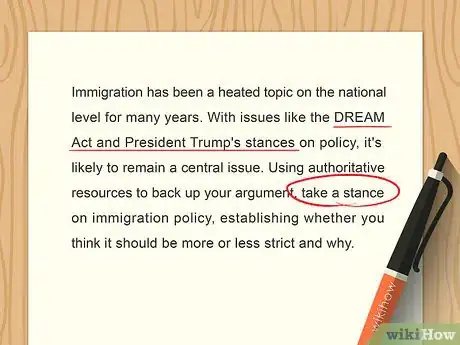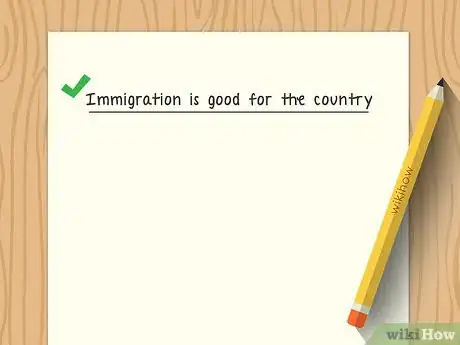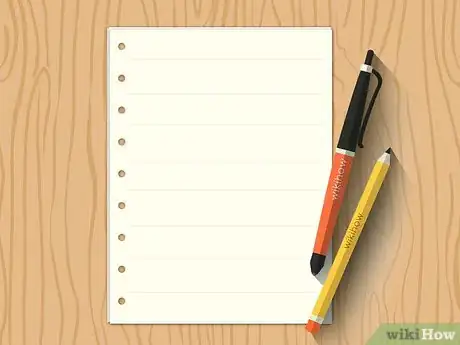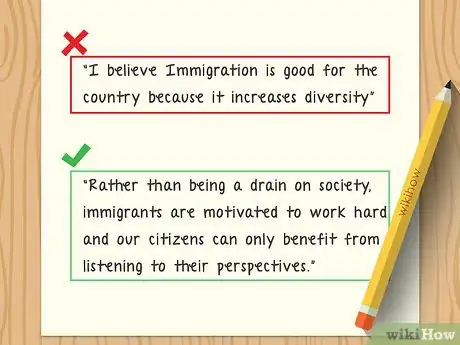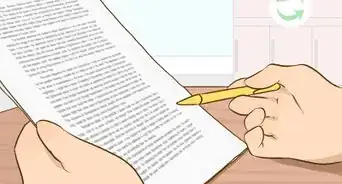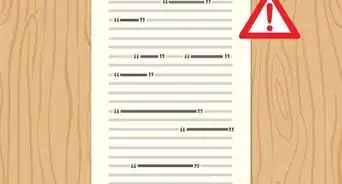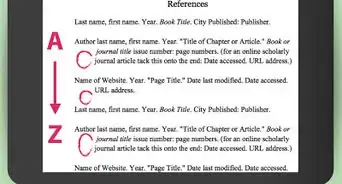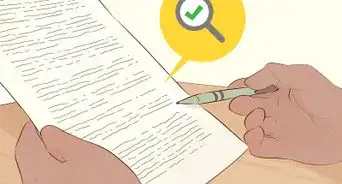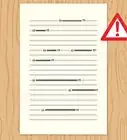This article was co-authored by Jake Adams. Jake Adams is an academic tutor and the owner of Simplifi EDU, a Santa Monica, California based online tutoring business offering learning resources and online tutors for academic subjects K-College, SAT & ACT prep, and college admissions applications. With over 14 years of professional tutoring experience, Jake is dedicated to providing his clients the very best online tutoring experience and access to a network of excellent undergraduate and graduate-level tutors from top colleges all over the nation. Jake holds a BS in International Business and Marketing from Pepperdine University.
There are 11 references cited in this article, which can be found at the bottom of the page.
This article has been viewed 419,568 times.
A discussion essay, also known as an argumentative essay, is one where you take a position on an issue. Start by taking a side, researching your topic, and outlining your essay before launching into the introduction and your thesis statement.[1] Create a cohesive argument in the body of your essay, and use your conclusion to draw it all together without introducing new information.
Steps
Planning Your Essay
-
1Work through the question to make sure you understand it. Take the question your teacher gave you, and read through it carefully. Look up any words and phrases you don't understand to get a better grasp of the question. Establish what the issue at hand is.[2]
- For instance, maybe the question is, "Immigration has been a heated topic on the national level for many years. With issues like the DREAM Act and President Trump's stances on policy, it's likely to remain a central issue. Using authoritative resources to back up your argument, take a stance on immigration policy, establishing whether you think it should be more or less strict and why."
- You can establish that the main topic is immigration policy from the sentence, "Take a stance on immigration policy."
- If you're having trouble understanding the question, don't be afraid to talk to the professor. They can help you better understand what they're asking for.
-
2Perform initial research to understand the issue. If you don't know much about the topic, do some reading to understand it better, starting with your textbook if it has information on the topic. Otherwise, use the internet to research the topic for this part, making sure to choose credible sources on both sides of the issue.[3]
- If your essay will be based off a discussion had in class, ask your instructor if you can use class notes as a primary source.
- Look for respected news sources, as well as websites with ".edu" and ".gov" extensions.
- You may need to look up information on the DREAM Act or President Trump's policies to help you understand the question, for example. For this part, you don't need to take extensive notes, as you're just trying to get a feel for the subject.
Advertisement -
3Take a side on the issue to begin outlining your essay.[4] After reading about both sides carefully, decide what position you want to take. Write your position at the top of a sheet of paper or at the top of a word processing document to start your outline.
- If you were given a text to base your essay on, make sure that text has enough evidence to support your chosen position.
-
4Add the main points you'd like to cover to your outline. After taking a side, think about the initial reading you did. What main points persuaded you to take that position? You can use those as the main points in your paper.[5]
- Use Roman numerals on your page to mark your main ideas. Write a main point by each Roman numeral. You should only cover 3 to 4 main points in a relatively short essay, such as one that's 3 to 5 pages.
-
5Find research to support your points. Now it's time to dig into your research. Head to the library or use your library's academic databases online. Find credible resources that you can use to establish your argument.[6]
- Your main sources should be books or ebooks, journal articles from academic journals, and credible websites. You can also use high quality news articles if they're applicable to your topic.
-
6Take notes that include citations. You can take handwritten notes or use a computer for this. As you read from relevant sources, take notes as you go along. Write the book title or article information at the top of the page, and add the page number by each section you take notes on or quote, if applicable.
- For a book, you should include the author's name, the editor's name (if applicable), the title of the book, the publication year, the publication city, the edition, and the title of the book chapter in an anthology by multiple authors.
- For a journal, include the author's name, the journal title, the article title, the digital object identifier (DOI), the ISSN, the publication date, the volume (if applicable), the issue (if applicable), and the page numbers for the journal article.
- If you're searching in a database, you can often ask the database to save this information for you, but you should include identifiers on your notes.
-
7Fill in your outline to finish planning your essay. Once you've taken your notes, add 3-4 bullet points underneath each main idea. Fill in points to back up the main idea, adding notes from your research.[7]
- For example, if one of your main points is "Immigration increases diversity," some of your points underneath might be "Brings in new cuisines," and "Brings in new art."
- Find examples from your research, and add notes to each point to fill them in.
Writing the Introduction
-
1Begin with a hook such as a quotation or anecdote to engage readers.[8] A hook is the way you get a reader interested in your essay. For a discussion essay, you could use a quotation from someone whose viewpoint you agree with, for instance.[9]
- For an example or anecdote, start by telling a short story about something relevant to your topic. For instance, you might write the following for an essay on immigration, "When I was 4-years-old, my parents told me we were going on a long trip. After a bus ride, we spent nights walking, my dad carrying me most of the way. One day, we crossed a river. That day marked our first day in our new country."
-
2Introduce your topic in your transition sentences. In the next few sentences, you'll move from your hook, which is broad, to your thesis statement, which is narrow. As you go, you'll bring up the main topic of your essay to give your readers an idea of where you're headed. You should present both sides of the issue in a neutral way before stating your thesis.[10]
- For example, you might write, "Immigration is a highly-debated issue. It is controversial because some people fear how it affects the resources of the country the people are immigrating to, while others believe the improved quality of life for immigrants is what’s most important."
-
3Work on a thesis statement to establish your argument. After your transition sentences, you'll add your much narrower thesis statement, which tells the reader what you plan to argue.[11] You may want to include some phrases the help the reader understand what you'll cover as your main points.[12]
- For instance, your thesis statement might be, "Immigration is good for the country because it increases diversity, infuses the country with new talent, and broadens the population's perspective, and it should be encouraged with a few basic safeguards in place."
Composing the Body of Your Essay
-
1Limit each paragraph to 1 idea. To help focus your paper, use your outline to create your paragraphs. For a short essay, you can use 1 paragraph per main idea. If you're doing a longer essay, try writing 1 paragraph for each bullet point under the main points.[13]
- For instance, if you're writing a short research paper, one paragraph might be your main point "Immigration increases diversity," where you cover all your bullet points in that paragraph.
- If you're digging deeper, you might create a section about diversity, and then use a paragraph to cover "brings in new cuisines," another to cover "brings in new art," and so on.
-
2Acknowledge the other side of the issue. The best way to present your argument is to discuss the other side and show how it contrasts with your position. Explain the opposite perspective using a counterclaim, then detail why you think your position is better. You can choose how much time and space you want to devote to the other side of the issue, such as a single sentence or an entire paragraph.[14]
- Try not to set up a "straw man" argument, where you don't give the other side a fair chance. You should be able to support your position without purposefully creating a weak position on the other side.
-
3Keep your whole argument in mind as you write. Each main idea should connect to the next one, so that at the end you have a cohesive argument the reader can trace throughout your essay. Adding transitions between sections can help readers see the big picture.
- For instance, maybe you want to transition between a section about increasing diversity to one about bringing in new talent. You might write a sentence like, "Increasing diversity in our country doesn't just bring in new cuisines and art, it also brings in hard workers that have fresh perspectives on old problems in the workforce."
-
4Support your ideas with research. Use your notes to back up your ideas by citing sources as you go along. You don't need to cite every sentence, but you should cite any sentence with a main idea that you got from another source.[15]
- You can paraphrase other ideas or use direct quotes, but only use a direct quote if the author said something in a unique way. Otherwise, put it in your own words.
- You may want to begin body paragraphs with a quote from a relevant source. Then, explain or provide commentary on the quote and show how it supports your position.
- You can also use statistics to back up your research. For instance, if one of your arguments is that immigration doesn't increase crime, use statistics to back that up.
Concluding Your Essay
-
1Synthesize the information from your essay. The conclusion should draw what you've said throughout the essay together, bringing your points home for the reader. Help the reader see how each main point you made establishes your position and proves your thesis statement.[16]
- For instance, you might write, "A truly great country is one that celebrates differences and welcomes new ideas and perspectives. While immigration has some negative effects on a country, overall, allowing people from other countries to come in helps to spark new ideas and make the country a better and more interesting place to live. Rather than being a drain on society, immigrants are motivated to work hard and our citizens can only benefit from listening to their perspectives."
-
2Avoid restating your introduction. Many students want to just take the introduction and rewrite it for the conclusion. However, your conclusion should be more than that. It should provide the reader with a summation of why the issue is important and why you think your position is the correct one.
-
3Read your essay to proofread it and check for flow. After you finish your initial draft, go over your essay carefully. Read it once to see if it makes logical sense. Does one idea flow to the next one? If it doesn't, take time to fix it by adding transitions. Rewrite any sections that aren't clear.
- Once you have the flow down, read it again to check for grammatical mistakes and typos. It can help to read it aloud, as it slows you down and forces you to read every word.
Expert Q&A
Did you know you can get expert answers for this article?
Unlock expert answers by supporting wikiHow
-
QuestionIs it best to start a discussion essay with a question?
 Jake AdamsJake Adams is an academic tutor and the owner of Simplifi EDU, a Santa Monica, California based online tutoring business offering learning resources and online tutors for academic subjects K-College, SAT & ACT prep, and college admissions applications. With over 14 years of professional tutoring experience, Jake is dedicated to providing his clients the very best online tutoring experience and access to a network of excellent undergraduate and graduate-level tutors from top colleges all over the nation. Jake holds a BS in International Business and Marketing from Pepperdine University.
Jake AdamsJake Adams is an academic tutor and the owner of Simplifi EDU, a Santa Monica, California based online tutoring business offering learning resources and online tutors for academic subjects K-College, SAT & ACT prep, and college admissions applications. With over 14 years of professional tutoring experience, Jake is dedicated to providing his clients the very best online tutoring experience and access to a network of excellent undergraduate and graduate-level tutors from top colleges all over the nation. Jake holds a BS in International Business and Marketing from Pepperdine University.
Academic Tutor & Test Prep Specialist
-
QuestionHow do I structure an essay with multiple discussion points while still having few paragraphs?
 Alexander Peterman, MAAlexander Peterman is a Private Tutor in Florida. He received his MA in Education from the University of Florida in 2017.
Alexander Peterman, MAAlexander Peterman is a Private Tutor in Florida. He received his MA in Education from the University of Florida in 2017.
Test Prep Tutor Hi there! This is interesting, and there's no single "correct' way to approach this. However, I might dedicate each extended paragraph to each discussion point. Perhaps this would be a survey of discussion points on a larger topic, rather than a more specific paper? It depends on your assignment on whether this would be appropriate.
Hi there! This is interesting, and there's no single "correct' way to approach this. However, I might dedicate each extended paragraph to each discussion point. Perhaps this would be a survey of discussion points on a larger topic, rather than a more specific paper? It depends on your assignment on whether this would be appropriate. -
QuestionWhat's the best way to write an introduction?
 Alexander Peterman, MAAlexander Peterman is a Private Tutor in Florida. He received his MA in Education from the University of Florida in 2017.
Alexander Peterman, MAAlexander Peterman is a Private Tutor in Florida. He received his MA in Education from the University of Florida in 2017.
Test Prep Tutor
Warnings
- Remember you can't research forever. Often, the research stage absorbs a student so fully that the upcoming submission date seems unimportant. Make sure to leave yourself at least a few days to write your essay.⧼thumbs_response⧽
References
- ↑ Jake Adams. Academic Tutor & Test Prep Specialist. Expert Interview. 20 May 2020.
- ↑ https://student.unsw.edu.au/answering-assignment-questions
- ↑ Jake Adams. Academic Tutor & Test Prep Specialist. Expert Interview. 20 May 2020.
- ↑ Jake Adams. Academic Tutor & Test Prep Specialist. Expert Interview. 20 May 2020.
- ↑ https://student.unsw.edu.au/essay-and-assignment-planning
- ↑ http://www.butte.edu/services/library/learning/research-paper/resources.html
- ↑ https://student.unsw.edu.au/organising-your-ideas
- ↑ Jake Adams. Academic Tutor & Test Prep Specialist. Expert Interview. 20 May 2020.
- ↑ http://writingcenter.unc.edu/tips-and-tools/introductions/
- ↑ http://www.umuc.edu/current-students/learning-resources/writing-center/writing-resources/parts-of-an-essay/introductions.cfm
- ↑ Jake Adams. Academic Tutor & Test Prep Specialist. Expert Interview. 20 May 2020.
- ↑ http://www.umuc.edu/current-students/learning-resources/writing-center/writing-resources/parts-of-an-essay/introductions.cfm
- ↑ https://owl.english.purdue.edu/owl/resource/685/05/
- ↑ https://owl.english.purdue.edu/owl/resource/685/05/
- ↑ https://owl.english.purdue.edu/owl/resource/685/05/
- ↑ https://writingcenter.unc.edu/tips-and-tools/conclusions/
About This Article
To write a discussion essay, start by taking a side on the issue you're writing about, like "Immigration is good for the country." Then, outline the main points that made you decide to take that position and do research to find evidence that backs them up. Look for credible sources that can help you make your argument, and don't forget to cite them. Then, when you're writing your essay, devote 1 paragraph to each main point and include your evidence. For help writing the introduction and conclusion to your essay, scroll down!

